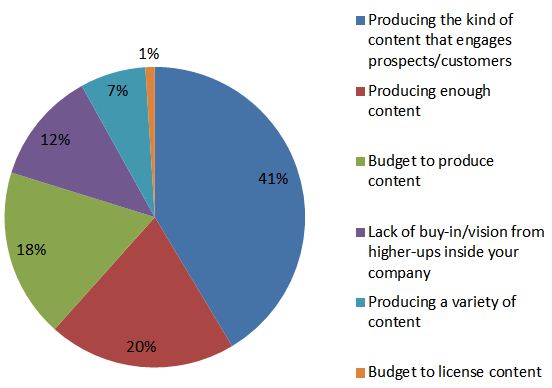First, some statistics: (these represent North America but the analogy is applicable to anywhere in the world) according to this research by Content Marketing Institute, MarketingProfs and Brightcove combined, 93% B2B marketers use content marketing one way or another. 42% of them say they are quite effective at it, this means they have a clue of what they are doing and they are getting positive results. $ 16.6 billion are being invested annually by B2B companies creating and publishing content. That’s a lot of money.
Content is needed everywhere, whether you get it written, videod, drawn or photographed. This is what people see, acknowledge, grasp and then base their decisions upon. It is the experience that they have on your website or blog. They wouldn’t bother checking out your online presence unless something draws them to it and what draws them to your website? Right, your content. You may think that it’s your product or service that is drawing them, but exactly what represents your product or service. If you’re selling mobile phones, you can’t put mobile phones on your website, can you? You need to put photographs. You need to publish their descriptions. If possible you also need to submit reviews. Then there are specifications, model details, et cetera. Whatever you put on your website, it’s content.
Why do B2B customers look for content, especially written content?
Take the mobile phones example. If you’re just a normal customer (and not a B2B customer) not much is at stake. At the most you may buy one or two mobile phones.
But what about the bulk buyer? He or she is your B2B customer. Maybe he or she is buying in bulk in order to sell the phones on his or her e-commerce website or even a normal retail store. Not only is he or she spending lots of money buying from you, he or she is also making a critical business decision. Wouldn’t he or she like to know more about your mobile phones? Wooden he or she like to know more about you as a reliable supplier of the product that he or she intends to sell? What are the prospects of selling these mobile phones? Primarily for what features would people buy these mobile phones? How many people are already buying these phones? If more people are buying these phones, why? What do the existing users have to say about these phones? Your B2B customer would like to know as much as possible about the product before investing so much money.
B2B customers do lots of research, and study. Otherwise they may end up losing lots of money. This is why they consume as much content as possible before making a decision in your favor.
Boosting your B2B business with content writing
So how does content writing help your B2B business (actually it sounds strange, “B2B business” means “business to business business)?
You need to convince your B2B customers that you are giving them a profitable deal. Profitable deal doesn’t just entail selling your product or service as cheap as possible, the more important thing is, you are reliable, trustworthy and above all, you have full knowledge of your field. If you are selling mobile phones of a particular brand at a particular time, you know the inside out of that mobile phone. You not only know the technical specifications, you also know exactly why people are buying that particular model and why your B2B customers should buy this phone in order to do further business. How can you achieve that? How can you instil such confidence among your B2B customers?
By constantly engaging them with your content. You need to satiate their desire to know more and more. Remember that when they come to your website they already have a plethora of apprehensions, and naturally. After all they are going to make a business investment. They’re going to spend lots of money on you. So they need to know more about your business, about you, and the product that they are about to purchase, in bulk, by paying you lots of money. They need to feel confident. They need to feel at ease. The best way to instil confidence in them is to make them familiar to you, your presence and your product as much as possible. This can be done by writing content regularly. Useful content. Content that helps them make a decision.
Now, the decision doesn’t necessarily have to be in your favor – your primary motive for publishing content is helping people make a better decision for themselves (even if they don’t buy from you, the others will). Of course you have to draw a line. It’s no use publishing “helpful content” if all you are achieving is sending customers to your competitors.


 Businesses need websites to instantly provide relevant information to their visitors. They also need engaging content that prompts them to take an action, and eventually turn them into their paying customers and clients.
Businesses need websites to instantly provide relevant information to their visitors. They also need engaging content that prompts them to take an action, and eventually turn them into their paying customers and clients.